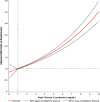Assessment of thirty-day readmission rate, timing, causes and predictors after hospitalization with COVID-19
- PMID: 33452824
- PMCID: PMC8013754
- DOI: 10.1111/joim.13241
Assessment of thirty-day readmission rate, timing, causes and predictors after hospitalization with COVID-19
Abstract
Background: There are limited data on the characteristics of 30-day readmission after hospitalization with coronavirus disease 2019 (COVID-19).
Objectives: To examine the rate, timing, causes, predictors and outcomes of 30-day readmission after COVID-19 hospitalization.
Methods: From 13 March to 9 April 2020, all patients hospitalized with COVID-19 and discharged alive were included in this retrospective observational study. Multivariable logistic regression was used to identify the predictors of 30-day readmission, and a restricted cubic spline function was utilized to assess the linearity of the association between continuous predictors and 30-day readmission.
Results: A total of 1062 patients were included in the analysis, with a median follow-up time of 62 days. The mean age of patients was 56.5 years, and 40.5% were women. At the end of the study, a total of 48 (4.5%) patients were readmitted within 30 days of discharge, and a median time to readmission was 5 days. The most common primary diagnosis of 30-day readmission was a hypoxic respiratory failure (68.8%) followed by thromboembolism (12.5%) and sepsis (6.3%). The patients with a peak serum creatinine level of ≥1.29 mg/dL during the index hospitalization, compared to those with a creatinine of <1.29 mg/dL, had 2.4 times increased risk of 30-day readmission (adjusted odds ratio: 2.41; 95% CI: 1.23-4.74). The mortality rate during the readmission was 22.9%.
Conclusion: With 4.5% of the thirty-day readmission rate, COVID-19 survivors were readmitted early after hospital discharge, mainly due to morbidities of COVID-19. One in five readmitted COVID-19 survivors died during their readmission.
Keywords: COVID-19; epidemiology; patient readmission; readmission mortality; readmission predictor.
© 2021 The Association for the Publication of the Journal of Internal Medicine.
Conflict of interest statement
All authors report no potential conflicts of interest to disclose.
Figures





References
-
- World Health Organization . WHO Director‐General's opening remarks at the media briefing on COVID‐19 ‐ 24 February 2020. https://www.who.int/dg/speeches/detail/who‐director‐general‐s‐opening‐re.... Accessed July 15, 2020.
Publication types
MeSH terms
LinkOut - more resources
Full Text Sources
Other Literature Sources
Medical
Miscellaneous

